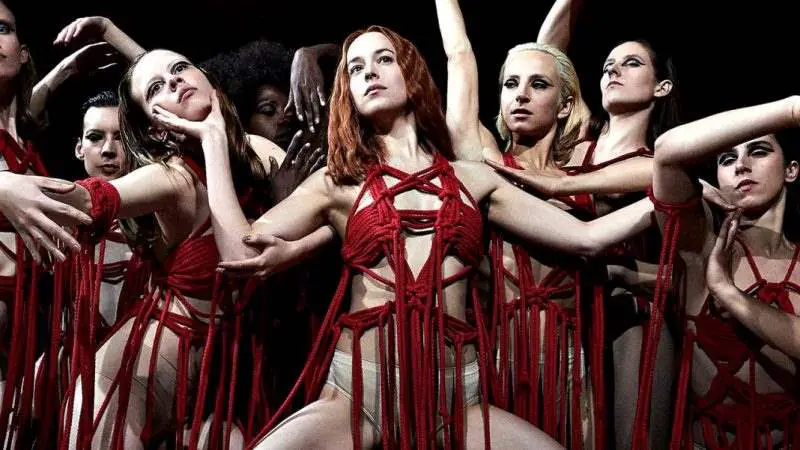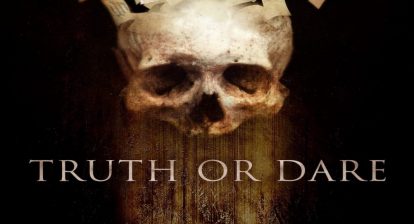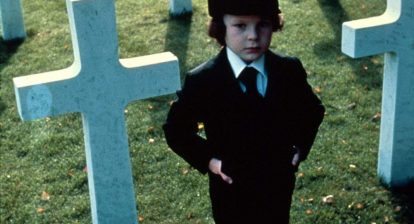Well, prepare to be shocked. Not since Darren Aronofsky’s Black Swan was released in 2010 has the fairytale atmosphere of the ballet world been so unsettling. The Suspiria update from Luca Guadagnino reminds one more of Black Swan than Dario Argento’s original. The similarity between Aronofsky’s psychological thriller and Guadagnino’s update does not begin and end with simply the ballet references. However, Suspiria is what would happen if Black Swan was gutted open by a witch with an oversized fish hook. And then she danced around naked.
Suspiria will likely invoke a strong reaction from audiences. As this happens to be its main objective, one can argue that the remake (revision, homage, etc.) is successful. Meaning, Guadagnino’s justification for this production was to create an homage to the feeling the original gave him. Often, when I am describing 1977’s version (or describing Dario Argento flicks, in general), I use phrases such as: “it’s not about the plot, it is how it makes you feel” or “it is like watching a dream, or nightmare, come to life on the screen.” I will give them the basic plot details regarding how an American ballerina, Suzy Bannion (Jessica Harper), is traveling to Germany to attend a ballet academy; however, I add in the suggestion that the story has very little to do with the film’s intention.
2018’s Suspiria revives the same general plotline, but has far more narrative depth than the original piece. Argento’s Suspiria uses ballet as an arbitrary device to pull the audience into the story. The plot is both straightforward and thin. Fans of the original understand this to be fine because the story is not Argento’s main focus. When showing the first version to friends, I find myself silently justifying in my head any narrative gaps. What occurs on the screen in this current incarnation is Guadagnino’s own interpretations to fill in those gaps. And he has plenty of ideas. There is an abundance of storylines, character developments, and dance sequences to fill out Argento’s 98 minute run time into a 152 minute film.
Also See: A Beginner’s Guide to Dario Argento
But, considering Argento’s intent was not to focus on storyline and instead emotion, is all this additional content a good thing? Art is generally considered to be subjective. If a person is a fan of a particular piece, then he or she usually tries to find the reasoning behind this admiration. In the medium of film, we are conditioned to make narrative sense out of what we are seeing. If there are too many holes or the plot becomes confusing, we are tempted to reject the picture as a good film.
The original Suspiria is one of the few exceptions to this rule. Guadagnino’s update is the director’s attempt to show what he loves about the original, while at the same time revealing his “silent justifications” of the plot. Argento’s piece is not about Suzy’s journey or growth as a character. Nor, is it specifically about witchcraft. These are machinations to get the viewer settled into a certain frame of mind.

So, in terms of plot, Guadagnino’s added ideas are dark and interesting. Whatever I found to be missing in the narrative of the original, this Suspiria has now delivered in spades. Truthfully, that leaves me feeling like I miss what was missing before. I did not see the ultimate reveal coming because I had Jessica Harper’s Suzy still in the back of my mind. Regardless, had that not been the case, I believe I would have found this outcome to be predictable. Obviously, having a preconceived expectation affected my outlook. Still, this plot twist seems like something I was subconsciously hoping would not happen. Mainly because it changes the lore of Argento’s Three Sisters Trilogy.
To be clear, I was conflicted with the twist of the ending. The finale, itself, is something to see and experience. The intense range of emotions I felt watching the climax unfold left me overwhelmed. Everything in the film leading up to the finale is uncompromisingly captivating. The film is, perhaps, bloated and could be trimmed down by about thirty minutes; however, Guadagnino tells a compelling story with shocking events. One such event involves temporary lead dancer, Olga (Elena Fokina), as she fights back against authority. The resulting sequence, as it is intercut with the frantic dancing of new Susie (Dakota Johnson), is relentlessly grotesque.
And that is where this new Suspiria is successful. Like the original, whether you love or hate it, you are going to feel penetrating emotions. These emotions could be awe or hate or terror. One could even feel resentment at Guadagnino’s clear manipulations. Others might enjoy having their emotions horrifically contorted for two and a half hours. There are few films that I watch where I am left wondering just what the heck do I feel? I noticed as the credits began to roll, nobody in the surprisingly full audience moved right away. One or two eventually rose to leave; however, the majority just sat there seemingly numb as they stared at the screen.
Related: Back to the ’80s: Dario Argento’s Phenomena
Similar to Argento’s original, there is something hypnotic to this remake. The result of this hypnosis is very different. After the first film, you snap out it as if you had just awakened from an intense nightmare. With this incarnation, you wake slowly as if from a drug-induced slumber. Of course, the cause might be the differing selections in color palette. Guadagnino elected for a muted color scheme which is a sharp contrast to the bright, Technicolor-effect from Argento’s choice. The earlier film tends to pop where the later choice subconsciously brings the viewer’s emotional level down.
No matter the color scheme, the Tanz Academy is brought to life with outstanding performances. Where company members seem to conveniently disappear in the original, this new release develops an intricate hierarchy between the cast of teachers and students that remains intact until the end. Or, if not completely “intact,” they at least have a part to play in the finale. Suspiria focuses on Dakota Johnson’s Susie Bannion. Johnson crawls with feline precision into the naïve and child-like quality of the character. Never losing her confidence, she develops Susie as one quietly stunned with her new surroundings into a woman ready to face her future.

While Johnson is decidedly the lead, Tilda Swinton is the star of this fresh take on Suspiria. Ever the chameleon, Swinton pours a unique quality into each of the three roles she played. Personally, I did not know about the publicity surrounding her portrayal of Dr. Josef Klemperer. She fooled me. And again as Helena Markos. She is equally fascinating as Klemperer and the lead choreographer, Madame Blanc. Particularly captivating is her enigmatic portrayal as the chain-smoking Blanc. She is like a deceitful spider spinning you into her web, and you are unable to resist being enthralled. Even as she is about to take her bite.
The rest of the company is composed of fascinating characters. Wanting to see everything, the viewer never quite knows where to look. Each student and teacher brings a different nuance to the screen. Particularly memorable are Sara Simms (Mia Goth) and Patricia Hingle (Chloe Grace Moretz). Goth’s character differs from her predecessor’s (Stefania Casini) portrayal. Where Casini’s Sara was overtly paranoid and suspicious, Goth is reluctant as she gradually comes to see the truth of her surroundings. She is concerned of Patricia’s disappearance; however, she has no doubts to the legitimacy of the academy. When the audience is introduced to Patricia, they are greeted with a young woman spiraling into madness. She is frantic in her movements and speech. As she claws away at her madness, Moretz delivers a bluntness that is both heartbreaking and terrifying.
An additional performance sweeps in at the eleventh hour of the film. Jessica Harper’s cameo is hauntingly sweet as Anke, the lost lover of Swinton’s Josef. Harper portrayed the inherently different Suzy from Argento’s creation. Little is known about her Suzy (in comparison to Johnson’s Susie) other than she has an aunt that was also a dancer. In contrast to the update, Harper’s Suzy appeared sophisticated and polite, albeit with a low tolerance for any nonsense. Johnson’s Susie has an ethereal quality encapsulated by a quiet fearlessness developed from a Mennonite childhood spent in Ohio.
One further change in Guadagnino’s interpretation is the handling of the dance sequences. A significant amount of ballets feature fairytales on the stage. Complete with vulnerable princesses and malevolent witches, the director does not shy away from utilizing these elements to tell his story. Accompanied by Thom Yorke’s eerily introspective score, the inclusion of specific dance movements punctuate each change in character or narrative development. Argento had minimal use for dance in his picture as it was primarily an arbitrary device. Dance is so essential to Guadagnino’s Suspiria that the film could almost be categorized as a ballet of the bizarre.
Related: How Argento’s Deep Red Influenced Surrealist Cinema
Everything comes together for this remake of Suspiria in a way that will leave audiences more exhausted than a ballerina performing a continuous series of fouette turns. And as shocked as if her ankle broke right on the stage. There is dark humor, breathless movements, and a grotesque horror that will leave haunting images in the viewer’s mind. The overwhelming range of ideas will attempt to drown the audience in a sea of emotion. Some audience members will resent what they have seen. Others will be fascinated. Either way, the effects of this Suspiria update will be lingering. And love it or hate it, that is what both Argento originally desired, and Guadagnino was hoping to achieve.

Wicked Rating 8/10
Director: Luca Guadagnino
Writer(s): David Kajganich, Based on Suspiria by Dario Argento and Daria Nicolodi
Stars: Dakota Johnson, Tilda Swinton, Mia Goth, Chloe Grace Moretz
Release: October 26, 2018 (United States, limited), November 2, 2018 (United States, wide-release)
Studio/Production Co: Amazon Studios, K Period Media, Mythology Entertainment, First Sun, Memo Films, Vega Baby
Language: English, German, French
Length: 152 minutes
Genre: Supernatural Horror






